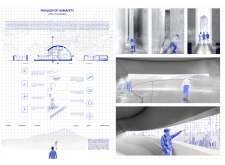5 key facts about this project
The Pavilion of Humanity is located in a mountainous area, designed to explore the deep connections between people and nature. The space functions as a public gathering site, focusing on interaction, exploration, and contemplation. The overall concept centers on the "Path of Variability," which reflects the modern human tendency to change and adapt surroundings while recognizing the importance of the natural world.
Conceptual Framework
The design captures the idea that humans have a strong desire to alter their environments, a drive that comes with both ambition and a need for humility. The pavilion’s structure follows the principles of the golden ratio. This mathematical approach helps create a circular form, providing a sense of balance and harmony within its spaces.
Spatial Interaction and Modularity
A key element of the pavilion is its use of movable modules, encouraging adaptability in how visitors experience the space. Users can rearrange rooms based on their needs, promoting personal exploration. This design strategy enhances engagement and shows how curiosity and discovery are vital to the overall experience.
Natural Light and Landscape Integration
Natural light significantly shapes the pavilion's interior environment. Narrow passages and well-placed skylights draw light into the building, guiding visitors as they move through the space. Water features that flow from the skylights into the floor gutters create a strong link between the pavilion and its natural surroundings, enriching the sensory experience.
Technology and Reflection
Incorporating holographic displays, the pavilion educates visitors about its core themes, including humanity, egoism, greed, and imperiousness. These technological elements encourage deeper thinking about the ideas presented. As visitors walk through the structure, they reach a sloped pathway that leads to a panoramic window. This window frames a view of the urban landscape, inviting reflection on the relationship between built environments and the natural world.
A quiet space for rest includes cavities in the walls that offer glimpses of the mountains outside. This design invites contemplation, allowing visitors to connect comfortably with both the architecture and the beauty of the natural setting.



















































